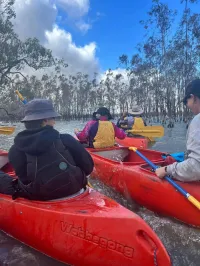0488 770 370
blog
Welcome to the Wildside Blog!
Embark on an adventure of discovery with the Wildside Outdoors blog. Here, we dive into everything from outdoor education to the thrilling experiences that define adventure in the Sunraysia region and beyond.
blog
Get Ready, Get Set, Get Outdoors!
Discover a world of adventure in Mildura and Sunraysia. Let us guide you to new experiences, essential tips, and all the tools you need to connect with nature. Don't miss out—check out our latest articles below!
latest blog posts

The Ultimate Guide to Hiking in Victoria
By Thomas Floyd
Welcome to Victoria, a hiker’s paradise where you’ll find everything from serene riverside walks to challenging mountain treks. Whether you’re just dipping your toes into hiking or a seasoned trail lover, this guide is packed with the essentials you need to enjoy a safe, fulfilling experience in Victoria’s natural beauty.
Hiking vs. Trekking: What’s the Difference?
Hiking and trekking are often used interchangeably, but they’re not quite the same. Knowing the difference can help you choose an experience that matches your adventure style and fitness level.
Hiking: Typically involves day trips on well-marked trails with less strenuous terrain. Ideal for a few hours to a full day of exploring.
Trekking: A multi-day, rugged adventure that often demands physical endurance, specialised gear, and mental grit.
Consider your time, fitness level, and gear before deciding between a relaxing day hike or an immersive trekking journey.
Finding Your Trail: Best Hiking Spots in Victoria
Victoria offers a diverse range of trails, each with unique scenic rewards. Here’s a list of must-visit hiking trails, from beginner-friendly paths to more challenging treks for experienced hikers.
Murray River Track, Mildura: A gentle trail along the Murray River, perfect for birdwatchers and those looking for a calm riverside experience.
Grampians Peaks Trail: A 160 km stretch through ancient sandstone mountains and lush greenery, offering both day hikes and multi-day adventures.
Great Ocean Walk: Follow the dramatic cliffs of Victoria’s coastline over 100 km, with camping sites along the way for an extended journey.
Wilsons Promontory: Victoria’s southernmost park, offering a range of hikes from gentle beach walks to steep mountain climbs with panoramic coastal views.
Cathedral Ranges: Test your endurance with steep, rocky ascents rewarded by stunning views. The Razorback Track is a popular choice for more experienced hikers.
Each of these spots is unique, and Wildside Outdoors is a great resource to help you explore more trails suited to your preferences.
Essential Gear: Packing for a Successful Hike
Packing the right gear can mean the difference between a great hike and a miserable one. Here’s a breakdown of must-have equipment for any hiker.
Hiking Boots
A good pair of hiking boots is the foundation of any successful hike. The right boots provide stability, comfort, and protection on rough terrain. Here’s what to consider when choosing hiking boots:
Terrain Compatibility: For rocky or uneven trails, opt for boots with strong ankle support. For flatter trails, lighter, more flexible boots will suffice.
Waterproofing: Waterproof boots are ideal for wet or muddy trails, keeping your feet dry and comfortable. Look for boots with a Gore-Tex lining or similar material.
Traction: Deep, multi-directional lugs provide excellent grip, especially in wet or muddy conditions. Vibram soles are widely recognized for high-quality traction.
Fit and Comfort: A snug fit without pinching or pressure points is essential to prevent blisters. Always try boots with the same socks you’ll use on your hike to ensure the right fit.
Hiking Backpack
A hiking backpack carries all your essentials, so it’s important to choose one that’s comfortable, durable, and suitable for your trip’s length. Here’s how to find the right backpack:
Capacity: Day hikes typically require 15-30 liters, while overnight or multi-day hikes may require 50-70 liters to accommodate additional gear.
Weight Distribution: Look for a backpack with a padded hip belt and shoulder straps to distribute weight evenly and reduce strain on your back and shoulders.
Water Resistance: A water-resistant or waterproof backpack is essential in unpredictable weather. If the pack isn’t waterproof, consider using a rain cover or dry bags inside.
Pockets and Accessibility: Side pockets, top compartments, and hydration reservoir sleeves allow for easy access to water, snacks, maps, and other essentials.
Hiking Jacket
A reliable hiking jacket keeps you comfortable in changing weather, providing warmth and protection from wind and rain. Here’s what to look for:
Weather Resistance: Choose a jacket that’s waterproof or water-resistant, especially if hiking in areas prone to rain. Look for materials like Gore-Tex or DWR-treated fabric.
Breathability: A breathable jacket is crucial for long hikes, as it helps regulate body temperature and prevents overheating. Jackets with pit zips allow extra ventilation when needed.
Lightweight and Packable: Opt for a lightweight jacket that can be easily packed into your backpack when not in use.
Insulation: If you’re hiking in colder weather, a jacket with an insulated lining can keep you warm without requiring multiple layers.
Hiking Tent
For overnight hikes, a good hiking tent is essential. It provides shelter, safety, and comfort, allowing you to rest and recharge. Here’s how to pick the right tent:
Weight and Packability: Lightweight, compact tents are ideal for hiking, as they won’t weigh you down. Consider ultralight models if you’re covering long distances.
Weather Protection: Look for a tent with a sturdy, waterproof rainfly and a durable floor. Double-wall construction provides added protection from wind and rain.
Ease of Setup: Choose a tent that’s easy to pitch, especially if you’re likely to set up camp in low-light conditions. Freestanding designs can be moved and adjusted easily.
Space and Comfort: Consider the tent’s capacity based on the number of people camping. A two-person tent is more spacious for solo hikers, while a one-person tent is lighter but less roomy.
What to Eat on the Trail: Hiking Meal Ideas
Proper nutrition keeps your energy up and makes the hike enjoyable. Here are some easy-to-pack options:
Hiking Lunch Ideas: Quick and Nutritious
Lunch on the trail should be easy, quick, and provide lasting energy. Some ideas:
Wraps: Whole grain wraps with lean protein and veggies.
Trail Mix: A mix of nuts, dried fruit, and a bit of chocolate for a quick energy boost.
Energy Bars: Look for high-protein, high-fiber options for sustained energy.
Hiking Dinner Ideas: Simple but Satisfying
For overnight hikes, dinner should be filling yet easy to prepare:
Dehydrated Meals: Lightweight and convenient, just add hot water.
Pasta: Quick to cook and provides plenty of carbs.
One-Pot Meals: A mix of grains, protein, and vegetables, cooked in a single pot for minimal cleanup.
Planning for the Elements: Weather and Terrain
Victoria’s weather can change quickly, and understanding the terrain will help you stay prepared. Before you head out:
Check the Weather Forecast: Pack accordingly, with extra layers if temperatures will fluctuate.
Layering System: Use a base layer to wick moisture, an insulating layer for warmth, and an outer layer for rain and wind protection.
Understand Terrain: Victoria has diverse landscapes; plan for trail conditions based on your chosen hike.
Safety and Preparation: Hiking with Confidence
Safety is a priority, especially in remote areas. Key tips:
Carry a First-Aid Kit: Include bandages, antiseptic, and any personal medications.
Bring Plenty of Water: Consider a hydration bladder for easy access.
Share Your Plan: Let someone know where you’re going and your expected return time.
Leave No Trace: Hiking Responsibly
Protecting nature is everyone’s responsibility. Follow these principles:
Pack Out Trash: Leave no litter on the trails.
Stick to Trails: Prevent erosion and avoid disturbing wildlife.
Respect Wildlife: Observe from a distance and never feed animals.
Capture the Moment: Photography Tips for Hikers
Nature offers endless beauty to capture, and with a few tips, you can enhance your photography:
Use Natural Light: Shoot during golden hours for the best lighting.
Rule of Thirds: Frame shots with an eye for balanced composition.
Mind the Environment: Capture beauty without disturbing the area around you.
Wrapping Up: Reflecting on Your Hiking Adventure
After a day of hiking, take a moment to soak in the experience. Think about what you enjoyed most, what you’d like to try next time, and remember to journal or photograph your favorite memories. Hiking is about more than just physical activity—it’s a way to reconnect with nature and yourself.
FAQs About The Ultimate Guide to Hiking in Victoria
1. What’s the best time of year for hiking in Victoria?
Spring and autumn are ideal, with moderate temperatures and beautiful scenery.
2. Can beginners enjoy hiking in Victoria?
Absolutely! There are plenty of beginner-friendly trails, like the Murray River Track in Mildura and paths in the Grampians.
3. How can I book a hike in Mildura?
To book a guided hike in Mildura, reach out to local adventure providers like Wildside Outdoors. They offer tailored hiking experiences that showcase the beautiful trails and landscapes of the area. Visit their website or contact them directly to reserve your spot and plan your Mildura hiking adventure.
4. What should I pack for a hike?
Essentials include water, snacks, a map, sunscreen, a first-aid kit, and extra layers to handle Victoria’s changing weather.
Victoria’s trails await! Whether you’re exploring a gentle riverside or challenging yourself in the mountains, this ultimate guide will help make your hiking experience in Victoria one for the books. Enjoy the journey and happy hiking!

FOLLOW US
ADVENTURE ACTIVITIES
CUSTOMER CARE
LEGAL
Copyright 2025. Wildside Outdoors. All Rights Reserved.


